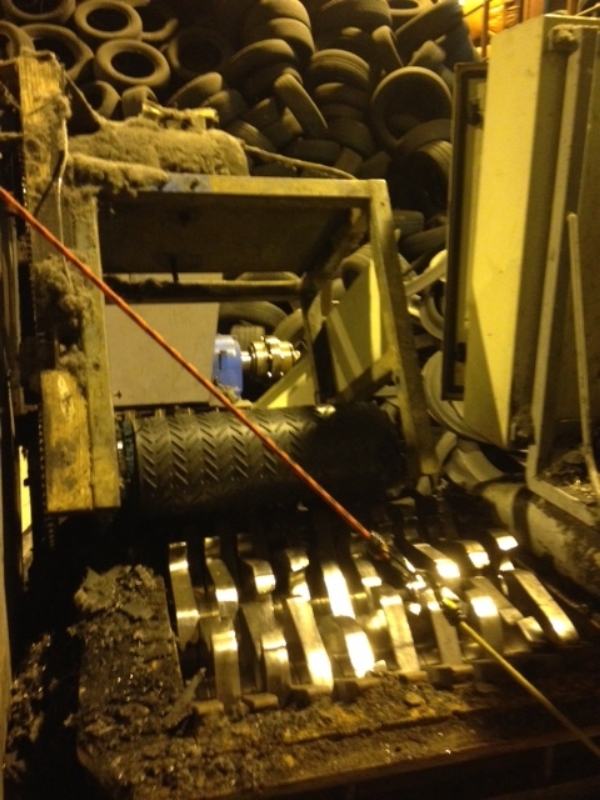Spot The Safety Violation: Entanglement Injuries Can Change Lives
What key safety measure is this tire shredder missing’

One the main hazards machinery and equipment poses to workers is the risk of entanglement. Workers’ hands, hair, clothing and jewellery can get caught in pinchpoints, moving parts, etc. And such entanglement can result in serious injuries, such as amputations, and even fatalities.
How do you protect workers from entanglement in machinery’ By ensuring that equipment has adequate guards’and that those guards aren’t disabled or removed.
This picture from the Health and Safety Executive in Great Britain shows an unguarded tire shredder. A 25-year-old worker was putting tires by hand into the shredder when it failed to grip one properly on its metal teeth. He grabbed the remaining half and fed it into the shredder. But his jacket sleeve got entangled on the teeth, dragging his fingers and then forearm into the running shredder.
As the worker screamed for help, the company’s sole director managed to switch the machine off and free him from the shredder. The worker lost the forearm up to his elbow and needed extensive hospital treatment, including skin grafts from his left leg to replace the remains of his arm and a bolt in his elbow to ensure it remained intact.
However, his injuries could’ve been even worse if he’d been working alone that day, which regularly happened in the company, because there were no emergency stop switches within his reach at the time.
The HSE’s investigation found that the director had removed a protective guard from the shredder only a couple of weeks earlier, allowing easy access to the metal teeth.
The director pleaded guilty to a safety offence. The court sentenced him to a four-month prison sentence, suspended for 12 months, home curfew between the hours of 8:00 pm and 6:00 am and electronic monitoring. He must also pay $5,000 to the injured worker.
In a victim statement to the court, the injured worker said, ‘It has knocked me back regarding my mobility and it is a struggle getting around. It has had a massive impact on my home life with my four children. I still suffer pain with the injuries.’
4 STEPS TO MACHINE GUARD COMPLIANCE
To avoid life-changing incidents such as this one in your workplace, ensure that any machinery with pinchpoints or other hazards is properly guarded. To do so, take the following steps to comply with the guarding requirements in the OHS laws:
1. Determine whether machinery needs guards. Conduct a hazard assessment to determine if any machinery in your workplace requires guards, such as if workers using or working near that equipment could be exposed to moving parts, pinchpoints, open flames or energized electrical cables or components.
2. Install appropriate guards. If you determine that guards are required, install appropriate ones. Proper guards should comply with the requirements under the OHS laws and generally have the following characteristics:
- Actually protect workers from the identified hazards. Machine guards must be adequate, effective and capable of performing their intended function, that is, protecting workers from the hazard from which it’s intended to shield them.
- Comply with any applicable standards. Depending on your OHS law, machine guards may need to comply with voluntary safety standards, such as CSA Standard Z432, Safeguarding of Machinery.
- Don’t create new hazards. A guard shouldn’t endanger workers or create new hazards.
- Don’t interfere with workers’ use of the machinery or equipment. Appropriate guards also shouldn’t interfere with the way workers do their work.
- Are difficult, if not impossible, to remove. The shredder in this picture actually had a guard’but the director removed it. An appropriate guard should be designed so that it can’t be removed or can only be removed with tools. (And you should specifically bar anyone from removing machine guards except under designated circumstances.)
- Allow for routine maintenance on the machinery without removal of the guard. If possible, choose a guard that permits repairs, lubrication and other routine maintenance tasks to be done while the guard is still in place.
Adapt and use this Machine Guarding Checklist to ensure that your machine guards meet these requirements.
3. Train workers on machine guards. It’s important to train workers on machine guards, including their purpose and how they work. Make sure that workers understand that they shouldn’t alter, tamper with or remove machine guards unless necessary to make a repair or do routine maintenance. And in that case, workers must follow safe work procedures while the guard is disabled, such as locking out the machinery.
The OHS Insider has articles, tools and other resources on locking out machinery and equipment in your workplace, including:
- How to comply with the lockout requirements under the OHS laws
- How to comply with the group lockout requirements
- Model Lockout Policy
- Model Lockout Procedure
- Lockout Hazard Identification and Risk Assessment Worksheet.
4. Properly maintain guards. Guards are only effective if they’re in good condition. So make sure that guards are properly maintained and repaired when necessary. And if a guard becomes in effective, replace it.